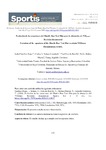Mostrar o rexistro simple do ítem
Evolución de las ecuaciones del Shuttle Run Test 20m para la obtención del VO2máx: Revisión documental
| dc.contributor.author | Sánchez Rojas, Isabel Adriana | |
| dc.contributor.author | Solano Castañeda, Carlos Andrés | |
| dc.contributor.author | Estrada Bonilla, Yisel Carolina | |
| dc.contributor.author | Molina Murcia, Pablo Sergio | |
| dc.contributor.author | Argüello, Yenny Paola | |
| dc.date.accessioned | 2024-05-15T17:38:26Z | |
| dc.date.available | 2024-05-15T17:38:26Z | |
| dc.date.issued | 2024-01-01 | |
| dc.identifier.citation | Sánchez Rojas, I. A., Solano Castañeda, C. A., Estrada Bonilla, Y. . C., Molina Murcia, P. S., & Argüello Gutiérrez, Y. P. (2024). Evolución de las ecuaciones del Shuttle Run Test 20m para la obtención del VO2máx: Revisión documental. Sportis. Scientific Journal of School Sport, Physical Education and Psychomotricity, 10(1), 131–157. https://doi.org/10.17979/sportis.2024.10.1.9637 | es_ES |
| dc.identifier.issn | ISSN-e 2386-8333 | |
| dc.identifier.uri | http://hdl.handle.net/2183/36484 | |
| dc.description.abstract | [Resumen] Para la evaluación del fitness cardiorrespiratorio existen pruebas directas en laboratorio que proporcionan información objetiva respecto a esta cualidad. No obstante, cuando no se cuenta con los recursos se recurre al uso de pruebas de campo como el Shuttle Run Test 20 metros (SRT-20m), el cual busca establecer el VO2max para cada sujeto, relacionando los valores obtenidos con aspectos como la composición corporal, edad y contexto poblacional, siendo una de las pruebas más confiables y con concordancia clínica existente. El propósito fue reconocer los cambios o variaciones presentes en los modelos matemáticos o lineales empleados en esta prueba con diferentes grupos poblacionales. Se realizó una revisión de la literatura bajo el marco básico para revisiones integradoras con algunas precisiones dadas por la guía PRISMA, identificando en su mayoría estudios de corte transversal los cuales evidencian los cambios realizados al planteamiento de la fórmula matemática donde las variables que inciden en el valor resultante para la resistencia aeróbica son: velocidad final, etapa de la prueba, edad y aspectos antropométricos del sujeto. Por lo anterior, se concluye que, para efectos prácticos, la estimación del VO2máx debe considerar factores intrínsecos del sujeto y aquellos relacionados con la ejecución de la prueba. | es_ES |
| dc.description.abstract | [Abstract] For the evaluation of cardiorespiratory fitness, there are direct laboratory tests that provide objective information regarding this quality. However, when the resources are not available, the use of field tests such as the Shuttle Run Test 20 meters (SRT-20m) is used, which seeks to establish the VO2max for each subject, relating the values obtained with aspects such as body composition, age, and population context, being one of the most reliable tests with existing clinical agreement. The purpose was to recognize the changes or variations present in the mathematical or linear models used in this test with different population groups. A review of the literature was carried out under the basic framework for integrative reviews with some clarifications given by the PRISMA guide, identifying mostly cross-sectional studies which show the changes made to the approach of the mathematical formula where the variables that affect the resulting value for aerobic endurance are final speed, stage of the test, age, and anthropometric aspects of the subject. Therefore, it is concluded that, for practical purposes, the estimation of VO2max should consider intrinsic factors of the subject and those related to the execution of the test. | es_ES |
| dc.language.iso | spa | es_ES |
| dc.publisher | Universidade da Coruña, Servizo de Publicacións | es_ES |
| dc.relation.uri | https://doi.org/10.17979/sportis.2024.10.1.9637 | es_ES |
| dc.rights | Atribución-NoComercial-CompartirIgual 3.0 España | es_ES |
| dc.rights.uri | http://creativecommons.org/licenses/by-nc-sa/3.0/es/ | * |
| dc.subject | Consumo máximo de oxígeno | es_ES |
| dc.subject | Test de Course Navette | es_ES |
| dc.subject | Test de Léger | es_ES |
| dc.subject | Test de ida y vuelta de 20 metros | es_ES |
| dc.subject | Maximal oxygen consumption | es_ES |
| dc.subject | Course Navette test | es_ES |
| dc.subject | Léger's test | es_ES |
| dc.subject | 20-meter round-trip test | es_ES |
| dc.title | Evolución de las ecuaciones del Shuttle Run Test 20m para la obtención del VO2máx: Revisión documental | es_ES |
| dc.title.alternative | Evolution of the Equations of the Shuttle Run Test 20m to Obtain VO2max: Documentary Review | es_ES |
| dc.type | journal article | es_ES |
| dc.rights.accessRights | open access | es_ES |
| UDC.journalTitle | Sportis. Scientific Journal of School Sport, Physical Education and Psychomotricity | es_ES |
| UDC.volume | 10 | es_ES |
| UDC.issue | 1 | es_ES |
| UDC.startPage | 131 | es_ES |
| UDC.endPage | 157 | es_ES |






